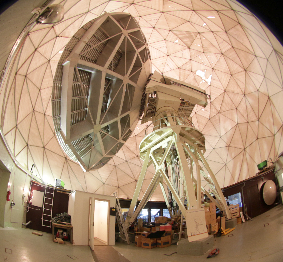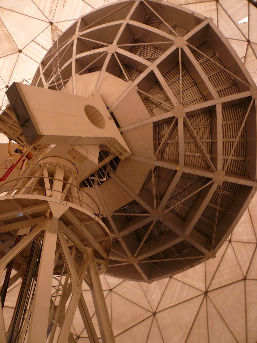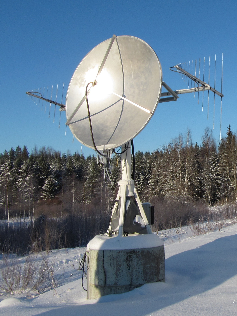14-metre radio telescope
The 14-metre telescope was built during 1973 and the first observations were conducted in 1974. Since then the telescope has been used actively in observing extragalactic radio sources, the Sun and in astronomical and geodetic VLBI observations. The receivers available for the telescope currently cover a frequency band of 2 to 90 GHz. The most frequently used frequencies are 37 GHz and 22 GHz for continuum observations of quasars and of the Sun. Astronomical Very Long Baseline Interferometry (VLBI) is conducted in 22, 43 and 89 GHz. Geodetic VLBI uses a dual band 2 / 8 GHz receiver. To accommodate the lower frequency, a larger 1.7-meter auxiliary reflector is installed during geo-VLBI sessions.
The telescope is a Cassegrain reflector mounted on a alt-azimuth mount. The exact diameter of the primary reflector is 13.7 metres. In 1992 the telescope's reflector structure was updated to a new one with 0.1 mm surface accuracy (rms). In 1994 a new dome was installed. Together, the updated reflector and dome allow observing frequencies of up to ~250 GHz. The highest tested frequency is 150 GHz.
Between 2008 and 2013 new digital backends were installed for the continuum receivers. Digital backends offer many performance benefits over their old analog counterparts. They provide e.g. a remote control capability and continuous averaging of signals. Another recent update is the installation of an electronically adjustable counterweight system that makes is easier to rebalance the telescope after a receiver change.
The utilization rate of the telescope is essentially 100%; excluding maintenance periods and bad weather the telescope is used around the clock every day of the year. The largest portion of observing time is used for continuum quasar observations, followed by solar observations, astronomical VLBI and geo-VLBI.


Solar monitoring telescopes
Metsähovi operates two instruments for continuous monitoring of the Sun at 50-1500 MHZ and 11.2 GHz. The 1.8-metre parabolic telescope is equipped with a 11.2 GHz receiver with 1 GHz bandwidth. The whole Sun fits in the beam of the telescope, allowing monitoring of the variation of the Sun's total flux. The dish is mounted on an alt-azimuth mount to allow tracking the Sun all day, year round. Two log-periodic antennas belonging to the international e-Callisto system are mounted on the sides of the 1.8-meter dish. The e-Callisto system functions between 50-1500 MHz and continuously gathers data on solar flares and other phenomena.

Metsähovi Radio Observatory
- Published:
- Updated: